

Daffodils: Plan Now, Plant Later
narcissus
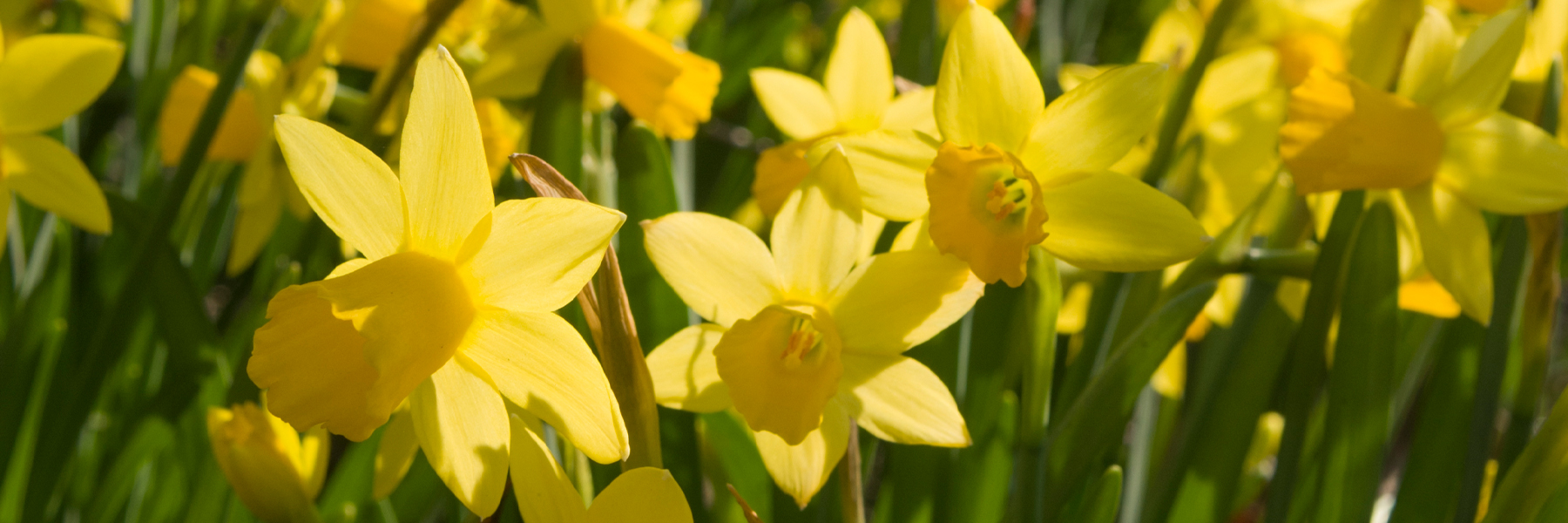
Nothing is better than a daffodil-filled spring view. Bird Island in peak daffodil bloom.
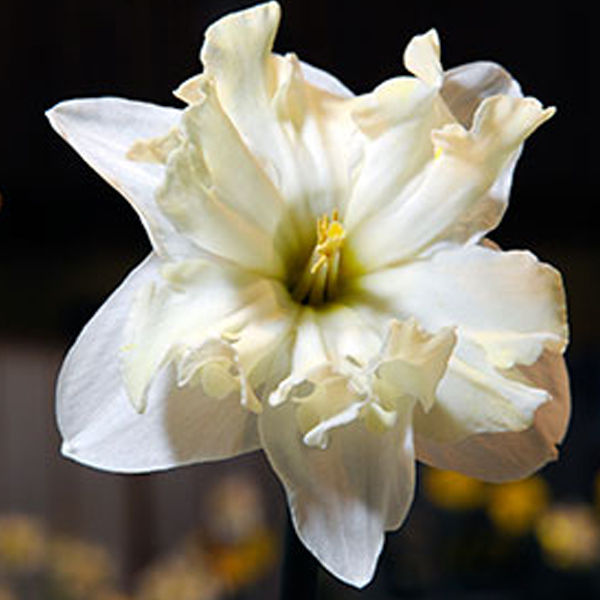
Antique Lace daffodil (Narcissus 'Antique Lace') lights up the garden in spring.
Long-lasting. Sturdy. Cold-tolerant. Fragrant. Sun-loving.
Pest-free. Gorgeous in a vase. Despised by deer.
No wonder daffodils are so beloved by Chicago area gardeners. Even their bulbs are recommended: they're large, moveable, colonize naturally, and, as long as they're not waterlogged, last for decades—possibly outliving the person who planted them.
In fact, there's only one real drawback to daffodils—you may not have planted enough of them last fall. You can remedy that with two simple planning steps this spring and some assistance from technology.
Step 1: Snap pix at home
First, head out to your yard at the first sign of spring and assess the daffodil opportunities. Where would daffodils work and where do you want them to show up next year?
Line a dull, bare spot along a sidewalk or walkway with clumps of daffodils, and be sure to look at your garden from your windows. Nothing's better than a daffodil-filled spring view.
Well-drained raised beds, rock gardens, and gentle slopes work great.
Daffodils need the sun through their leaves to recharge after blooming, but can be sited under shrubs and trees if the area is not heavily shaded in spring and early summer.
Avoid full shade or wet areas in the yard.
Get out your camera or smartphone and take photos of daffodil-friendly spots now, before perennials grow up, bare spots get covered, and leaves fill in on the trees. You are creating a photo map that will prove invaluable when fall, and your daffodil bulb order, arrive.
Need a more physical reminder of where you'll place daffodils? Use river rocks or stakes to mark your spots — any kind of marker will do, as long as it stands up to summer heat, wind, and storms.
Step 2: Snap pix at the Garden
Second, head up to the Chicago Botanic Garden in April—high season for daffodils. We have 538,651 planted here (give or take a few) and 231 varieties for you to see in situ before you order for fall.
How to find them? Our GardenGuide app (it's free) guides you to them, and it could prove to be your best memory tool.
All you need is an Android or iOS smartphone and a little background about how daffodils are categorized.
To put the GardenGuide app to work, download it from our website or the App Store. Look for "Plant Search" and enter "daffodils" or "Narcissus." Up pops a list of what's planted at the Garden, with location maps to guide you to each cultivar. Like a daffodil? Save it to "My Favorites," where you can easily retrieve it when it's time to place your bulb order.
Don't use a smartphone? Non-smartphone visitors can access the Plant Finder through their home computer, or use computer stations at two Garden locations.
The American Daffodil Society recognizes 13 divisions, based on flower and habit. For example, Division 1 refers to trumpet daffodils, Division 4 groups the double flowers together, and Division 7 lists jonquils. On our GardenGuide app, we use the descriptive name rather than the division number, but you'll find that many daffodil catalogs and nurseries organize by division.
Division
Description
Division 1:
Trumpet
Shown: Trumpet daffodil (Narcissus 'Las Vegas')
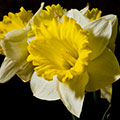
Divisions 1, 2, and 3 all share the classic daffodil look; they are separated only by the comparative length of the corona (cup) to the perianth (the petals). Of the three divisions, trumpets have the longest cup.
At the Garden, we often plant them by the thousands: 'Las Vegas' is a creamy, buttery yellow trumpet that you'll find in the Lakeside Gardens; 'Mount Hood' is an all-white heirloom with a touch of yellow found in the Sensory Garden.
Big daffodils with jumbo flowers look great from a distance. Plant them in drifts at the back of the yard or dotted under trees at the edge of your property—they're large enough to draw everyone's attention.
Division 2:
Large-cupped
Shown: Large-cupped daffodil (Narcissus 'Ice Follies')
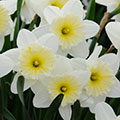
One of the first sights you'll see as you enter the Garden in April is Bird Island to the right of the entrance bridge. It's covered with 90,000 daffodils, including two of the most-planted large-cupped varieties of all time: 'Carlton', which has a big, gutsy, all-yellow flower; and 'Ice Follies', with creamy white petals and a yellow cup that eventually turns white, too. The GardenGuide app gives you handy close-up photos.
Division 3:
Small-cupped
Shown: Small-cupped daffodil (Narcissus 'Barrett Browning')
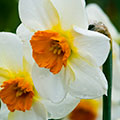
'Barrett Browning' has a shorter corona that looks perfectly proportioned because of its bright red-orange color, set against brilliant white petals. It's well worth the walk on the outer road (beyond the Bulb Garden) to see it in bloom.
Division 4:
Double
Shown: Double narcissus (Narcissus 'Cheerfulness')
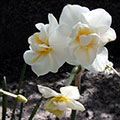
Often compared to camellias, these ruffly looking daffodils work especially well under flowering trees and shrubs. (Picture double-flowered daffodils and azaleas.) 'Yellow Cheerfulness' is an heirloom variety that's so pretty that we show it off in the Crescent Garden.
Division 5:
Triandrus
Shown: Triandrus daffodil (Narcissus 'Thalia')
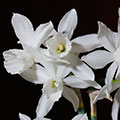
Evening Island is dotted with 14 daffodil varieties, including the beautiful 'Thalia', which has the multiple flowers, pendulous heads, and slightly reflexed petals typical of its division. 'Thalia' is pure white, which is unusual for daffodils, and thus works well when planted against a dark house, a dark green ground cover, or a dark hedge. We can't recommend it enough.
Division 6:
Cyclamineus
Shown: Cyclamineus daffodil (Narcissus 'Jetfire')
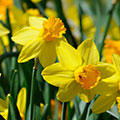
Much shorter than the trumpets, cyclamineus make up for height with sheer drama—each bloom's long, narrow cup faces forward, while the very reflexed petals "fly" back. 'Surfside', a yellow cup/white petal variety, is found along the Lakeside Gardens, and 'Jetfire' is a staff favorite with an orange cup and yellow petals. Plant them where passersby can stop in their tracks, admire, and comment.
Division 7:
Jonquilla
Shown: Jonquilla daffodil (Narcissus 'Sweetness')
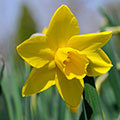
Some small-cupped flowers with big fragrances are jonquils, which may not be as long-lived as other daffodils in our area, but their heady fragrances seduce many gardeners. 'Sweetness' blooms along the West Flower Walk between the McGinley Pavilion and the Enabling Garden. Snap a close-up photo while you're inhaling its scent.
Division 8:
Tazettas
Shown: Paperwhites (Narcissus tazetta)
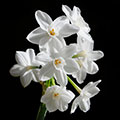
Tazettas aren't hardy in our Zone 5 area, but they're worth the investment for planters and containers. Why? Because each stem bears from three to 20 flowers. Paperwhites are classic, well-known tazettas.
Division 9:
Poeticus
Shown: Poeticus daffodil (Narcissus 'Actaea')
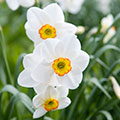
Simple, elegant, and beautiful in a bud vase, 'Actaea' is the classical poet's daffodil with six wide petals and a tiny, flat cup that's yellow with a red edge. You'll find 15,000 of them planted on Evening Island alone.
Division 10:
Bulbocodium Hybrids
Shown: Narcissus bulbocodium 'Golden Bells'
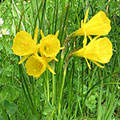
Rock gardens are ideal places to plant dwarf daffodils, including the bulbocodium hybrids. Their signature is a small stature and a large corona with virtually no petals. Look for examples near the Rock Garden.
Division 11:
Split-Corona (Collar, Papillon)
Shown: Split-cupped collar daffodil (Narcissus 'Mary Gay Lirette')

When the flower cup is divided so deeply that it looks like an extra set of petals, a daffodil is categorized as a split-corona. Take the path to the council ring on Evening Island to see a lovely example, 'Mary Gay Lirette'.
Division 12:
Miscellaneous
Shown: Dwarf narcissus (Narcissus 'February Gold')
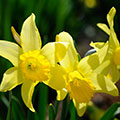
Some miniature daffodils and not-quite-in-a-category varieties find a home in Division 12.
Division 13:
Species
Shown: Hoop petticoat daffodil (Narcissus bulbocodium var. conspicuus)
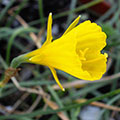
Species daffodils are the wild "originals." Narcissus bulbocodium var. conspicuus, commonly called the hoop petticoat daffodil, is one of the species that gave rise to the hybrids in Division 10.
Ready to Order!
Come August, when the bulb catalogs arrive, you'll thank yourself for recording your favorites on our app, because it will make ordering a snap. Come November, you'll thank yourself again when the bulbs arrive and your spring garden photos (and physical placeholders) tell you exactly where each daffodil clump, patch, or drift should be placed.
Watch this space. In November, we'll talk about how to plant daffodils and other bulbs. By this time next spring, and for dozens of springs to follow, smart gardeners will be enjoying a garden full of daffodils.
Karen Zaworski is a garden writer and photographer who lives and gardens in Oak Park, Illinois.

